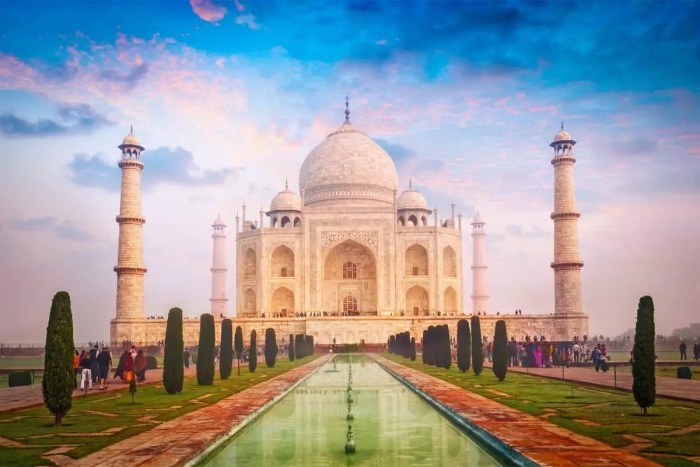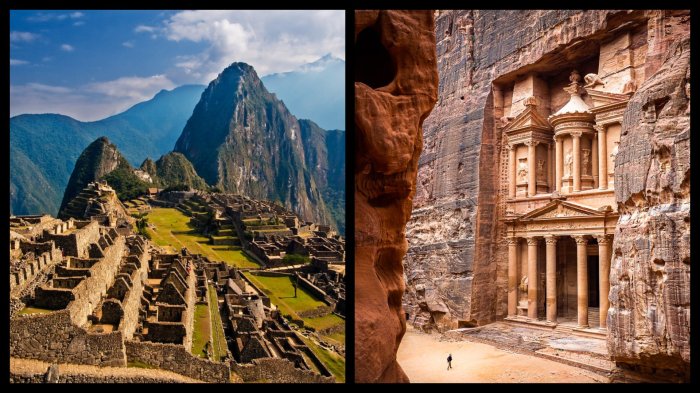UNESCO World Heritage Sites: A Tapestry of Cultural and Natural Treasures invites readers to embark on an enthralling journey through history, culture, and nature. This comprehensive guide delves into the significance and impact of these remarkable sites, providing a multifaceted perspective on their preservation and global importance.
From ancient ruins to breathtaking landscapes, UNESCO World Heritage Sites stand as testaments to human ingenuity and the beauty of the natural world. This narrative unravels the stories behind these iconic landmarks, exploring their cultural, historical, and environmental significance.
UNESCO World Heritage Site Designation Criteria: UNESCO World Heritage Sites

UNESCO World Heritage Sites are designated based on ten selection criteria, which assess the cultural and natural significance of the site.
These criteria are:
Outstanding Universal Value
- The site represents a masterpiece of human creative genius.
- Example: The Taj Mahal, India
Exceptional Natural Beauty, UNESCO World Heritage Sites
- The site contains superlative natural phenomena or areas of exceptional natural beauty.
- Example: The Great Barrier Reef, Australia
Unique or Rare Geological and Physiographical Formations
- The site contains unique or rare geological and physiographical formations.
- Example: The Giant’s Causeway, Northern Ireland
Exceptional Biological Diversity
- The site contains exceptional biological diversity, including threatened species and habitats.
- Example: The Amazon Rainforest, South America
Outstanding Example of a Traditional Human Settlement
- The site represents an outstanding example of a traditional human settlement, land-use, or sea-use that is representative of a culture.
- Example: The Old Town of Dubrovnik, Croatia
Directly Associated with Events or Living Traditions
- The site is directly associated with events or living traditions that have outstanding universal significance.
- Example: The Acropolis, Greece
Exceptional Testimony to a Cultural Tradition
- The site represents an exceptional testimony to a cultural tradition or civilization that is still alive or has disappeared.
- Example: The Pyramids of Giza, Egypt
Outstanding Example of Architectural or Technological Ensemble
- The site represents an outstanding example of an architectural or technological ensemble that illustrates significant stages in human history.
- Example: The Sydney Opera House, Australia
Landscape of Outstanding Universal Value
- The site represents a landscape of outstanding universal value that is the result of the interaction between humans and their environment.
- Example: The Grand Canyon, USA
Directly Associated with Historical Events
- The site is directly associated with historical events that have had a profound impact on the course of human history.
- Example: The Battlefields of Verdun, France
These criteria are used to assess the cultural and natural significance of a site and to determine whether it is worthy of being designated as a UNESCO World Heritage Site.
Types of UNESCO World Heritage Sites
UNESCO World Heritage Sites are classified into three categories: cultural, natural, and mixed.
Cultural Sites
Cultural sites are those that have been created by humans, such as monuments, buildings, and cities. They are significant for their historical, architectural, or artistic value.
| Site | Location | Year of Inscription |
|---|---|---|
| Taj Mahal | India | 1983 |
| Great Wall of China | China | 1987 |
| Machu Picchu | Peru | 1983 |
Natural Sites
Natural sites are those that have been created by nature, such as forests, mountains, and lakes. They are significant for their geological, ecological, or biological value.
| Site | Location | Year of Inscription |
|---|---|---|
| Grand Canyon | United States | 1979 |
| Great Barrier Reef | Australia | 1981 |
| Mount Everest | Nepal/China | 1979 |
Mixed Sites
Mixed sites are those that have both cultural and natural significance. They are significant for their unique combination of human and natural features.
| Site | Location | Year of Inscription |
|---|---|---|
| Yellowstone National Park | United States | 1978 |
| Uluru-Kata Tjuta National Park | Australia | 1987 |
| Plitvice Lakes National Park | Croatia | 1979 |
Geographical Distribution of UNESCO World Heritage Sites
The UNESCO World Heritage Sites are not evenly distributed across the globe. Some regions have a higher concentration of these sites than others. Various factors influence this distribution, including historical, cultural, and natural factors.
Factors Influencing Geographical Distribution
- Historical Significance: Many UNESCO World Heritage Sites are recognized for their historical significance. Regions with a rich and diverse history tend to have more of these sites.
- Cultural Diversity: Cultural diversity is another factor that influences the geographical distribution of UNESCO World Heritage Sites. Regions with a wide range of cultural traditions and expressions are more likely to have a higher number of these sites.
- Natural Heritage: UNESCO World Heritage Sites also include natural wonders, such as forests, mountains, and lakes. Regions with unique and diverse natural features are more likely to have a higher number of these sites.
- Tourism: Tourism can also play a role in the geographical distribution of UNESCO World Heritage Sites. Regions that are popular tourist destinations tend to have more of these sites.
Importance of Preserving Heritage Sites in All Regions
It is important to preserve heritage sites in all regions of the world. These sites are not only a source of pride and identity for local communities but also contribute to global cultural and natural heritage. Preserving these sites ensures that future generations can appreciate and learn from the rich history and diversity of our planet.
Cultural Significance of UNESCO World Heritage Sites

UNESCO World Heritage Sites are not just about preserving historical monuments and natural wonders; they also hold immense cultural significance. These sites represent the diversity of human expression and creativity, providing valuable insights into our past and present.
UNESCO recognizes the importance of cultural heritage in shaping human identity and fostering intercultural dialogue. World Heritage Sites are designated as such because they embody outstanding universal value, representing the pinnacle of human achievement and cultural diversity.
Cultural Traditions, Beliefs, and Practices
Many UNESCO World Heritage Sites showcase cultural traditions, beliefs, and practices that have been passed down through generations. These sites provide a tangible connection to the past, allowing us to witness the richness and diversity of human culture.
For example, the Historic City of Sucre in Bolivia is home to a unique blend of indigenous and Spanish colonial architecture, reflecting the region’s complex history and cultural influences. The Great Barrier Reef in Australia is not only a natural wonder but also holds cultural significance for the Aboriginal and Torres Strait Islander peoples, who have a deep spiritual connection to the reef and its ecosystem.
UNESCO World Heritage Sites serve as living testimonies to the diversity and ingenuity of human culture, offering a glimpse into the traditions, beliefs, and practices that have shaped our world. By preserving and celebrating these sites, we ensure that future generations can continue to appreciate and learn from the richness of human heritage.
Natural Significance of UNESCO World Heritage Sites
UNESCO World Heritage Sites possess immense natural significance, protecting unique ecosystems, extraordinary biodiversity, and awe-inspiring geological formations. These sites serve as invaluable scientific laboratories, offering insights into Earth’s processes and the evolution of life on our planet.
The protection and preservation of natural heritage are crucial for maintaining the ecological balance and ensuring the well-being of future generations. UNESCO World Heritage Sites play a vital role in this endeavor, safeguarding irreplaceable natural assets and contributing to sustainable development.
UNESCO World Heritage Sites offer an unparalleled glimpse into the world’s cultural and natural treasures. From the awe-inspiring ruins of ancient civilizations to breathtaking landscapes, these sites are a must-see for any traveler. While visiting these sites can be an unforgettable experience, it can also be expensive.
Fortunately, there are ways to make it more affordable for families. Consider visiting during the off-season or taking advantage of budget family vacations packages. By planning ahead, you can experience the wonders of UNESCO World Heritage Sites without breaking the bank.
Biodiversity Conservation
UNESCO World Heritage Sites are home to a vast array of plant and animal species, including many endangered and endemic species. These sites provide critical habitats for threatened wildlife, ensuring their survival and genetic diversity. For example, the Galapagos Islands, a UNESCO World Heritage Site, are renowned for their unique and diverse ecosystem, including iconic species like giant tortoises and marine iguanas.
Geological Formations
UNESCO World Heritage Sites also protect exceptional geological formations that showcase the Earth’s history and the forces that have shaped our planet. These sites offer valuable insights into geological processes, such as volcanic activity, erosion, and plate tectonics. For instance, the Grand Canyon, a UNESCO World Heritage Site, exposes layers of sedimentary rock that span millions of years, providing a captivating glimpse into Earth’s geological past.
Scientific Research
UNESCO World Heritage Sites serve as natural laboratories for scientific research. Scientists conduct studies in these sites to understand ecological processes, species behavior, and the impacts of human activities on the environment. This research contributes to the development of conservation strategies and informs policies aimed at protecting natural heritage.
Management and Preservation of UNESCO World Heritage Sites

Managing and preserving UNESCO World Heritage Sites is a complex and multifaceted task that involves balancing the needs of conservation, tourism, and local communities. Various challenges exist, including environmental degradation, climate change, and uncontrolled development. To address these challenges, a collaborative approach is essential, involving local communities, governments, and international organizations.
UNESCO World Heritage Sites are exceptional cultural and natural landmarks that deserve a spot on any traveler’s bucket list. However, planning a trip to these destinations can be daunting, especially when it comes to budgeting. To make the process easier, consider using a travel budget calculator to estimate expenses and stay within your financial means.
With careful planning, you can explore these iconic UNESCO World Heritage Sites without breaking the bank.
Role of Local Communities
Local communities play a vital role in the management and preservation of World Heritage Sites. They possess invaluable knowledge about the cultural and natural heritage of their region and can contribute to conservation efforts through traditional practices and sustainable tourism initiatives. Engaging local communities in decision-making processes and providing them with economic incentives for preservation can help foster a sense of ownership and responsibility.
Role of Governments
Governments have the primary responsibility for protecting and managing World Heritage Sites within their borders. This involves establishing legal frameworks, enforcing regulations, and providing funding for conservation projects. Governments can also collaborate with local communities and international organizations to develop comprehensive management plans and ensure sustainable tourism practices.
Role of International Organizations
International organizations, such as UNESCO and the World Bank, provide technical assistance, funding, and capacity-building programs to support the management and preservation of World Heritage Sites. They also monitor the state of conservation and provide guidance on best practices. International collaboration is crucial for addressing transboundary issues and sharing knowledge and expertise.
With an abundance of UNESCO World Heritage Sites, many destinations offer a rich tapestry of cultural and natural wonders. As you plan your travel itinerary for 2024, consider exploring these best travel destinations that showcase the planet’s most remarkable heritage sites.
From ancient ruins to breathtaking landscapes, UNESCO World Heritage Sites offer a glimpse into the world’s shared cultural and natural legacy.
Examples of Successful Conservation Efforts
- The restoration of the Angkor Wat temple complex in Cambodia, which involved a massive international effort to conserve the ancient ruins and promote sustainable tourism.
- The conservation of the Galapagos Islands in Ecuador, where strict regulations and community-based conservation initiatives have helped protect the unique biodiversity of the archipelago.
- The revitalization of the historic city of Hoi An in Vietnam, where a UNESCO-led conservation project helped preserve the traditional architecture and promote cultural tourism.
These examples demonstrate the effectiveness of collaborative management approaches that involve local communities, governments, and international organizations. By working together, these stakeholders can ensure the long-term preservation of UNESCO World Heritage Sites for future generations.
Tourism and UNESCO World Heritage Sites

UNESCO World Heritage Sites are places of outstanding universal value that are protected for their cultural or natural significance. Tourism plays a significant role in the preservation and promotion of these sites, but it can also pose challenges to their integrity.
Benefits of Tourism
- Economic development: Tourism can create jobs and boost local economies, particularly in areas where there are few other sources of income.
- Increased awareness: Tourism can raise awareness of UNESCO World Heritage Sites and their importance, encouraging people to appreciate and protect them.
- Educational opportunities: Visiting UNESCO World Heritage Sites can provide educational opportunities, allowing people to learn about different cultures and histories.
Challenges of Tourism
- Overcrowding: Excessive tourism can lead to overcrowding, which can damage the site’s physical structures and natural environment.
- Pollution: Tourism can generate pollution, including air, water, and noise pollution, which can harm the site’s ecosystems and cultural heritage.
- Cultural erosion: Tourism can lead to the erosion of local cultures and traditions, as tourists may expect sites to conform to their own cultural norms.
Recommendations for Sustainable Tourism Practices
- Limit visitor numbers: Managing the number of visitors to a site can help to prevent overcrowding and damage.
- Use sustainable transportation: Encouraging visitors to use public transportation or walk can reduce air pollution and traffic congestion.
- Educate visitors: Providing visitors with information about the site’s significance and how to behave respectfully can help to minimize damage.
- Support local businesses: Encouraging visitors to support local businesses can help to spread the economic benefits of tourism throughout the community.
UNESCO World Heritage Sites as Symbols of Global Heritage

UNESCO World Heritage Sites are not just individual landmarks or natural wonders; they are symbols of our shared human heritage. They represent the collective achievements of humanity and the natural beauty that we all share.
These sites foster international cooperation and understanding by bringing people together from all over the world to appreciate and learn from each other’s cultures and histories. They also serve as a reminder of our common humanity and the importance of preserving our shared heritage for future generations.
Examples of UNESCO World Heritage Sites that have played a significant role in promoting peace and reconciliation
- The Hiroshima Peace Memorial (Japan) is a reminder of the horrors of war and the importance of peace.
- The Auschwitz-Birkenau Concentration Camp (Poland) is a reminder of the Holocaust and the importance of fighting against hatred and intolerance.
- The Great Wall of China (China) is a symbol of the Chinese people’s resilience and determination.
Wrap-Up
As we conclude our exploration of UNESCO World Heritage Sites, it becomes evident that these treasures transcend mere preservation. They serve as symbols of our shared heritage, fostering global cooperation and understanding. By safeguarding these sites, we not only protect the past but also invest in the future, ensuring that generations to come can continue to marvel at the wonders of our world.
FAQ Overview
What is the purpose of UNESCO World Heritage Sites?
UNESCO World Heritage Sites are designated to protect and preserve cultural and natural landmarks of outstanding universal value for the benefit of humanity.
How many UNESCO World Heritage Sites are there?
As of 2023, there are 1154 UNESCO World Heritage Sites in 167 countries.
Who decides which sites become UNESCO World Heritage Sites?
The World Heritage Committee, composed of 21 elected countries, reviews nominations and makes decisions on which sites to inscribe on the World Heritage List.